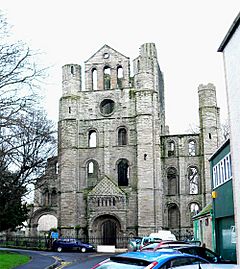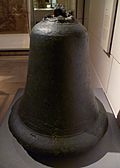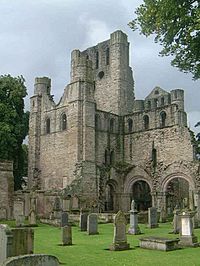Kelso Abbey facts for kids

Kelso Abbey
|
|
| Monastery information | |
|---|---|
| Full name | Kelso Abbey |
| Order | Tironensian |
| Established | Community first established at Selkirk c. 1113, moved to Kelso 1128. |
| Disestablished | 1559 |
| People | |
| Founder(s) | David I of Scotland |
| Site | |
| Location | Kelso, Scottish Borders, Scotland |
| Visible remains | Fragments: Western Crossing, Infirmary. |
| Public access | Yes |
Kelso Abbey is a ruined Scottish abbey in Kelso, Scotland. It was founded in the 12th century by a community of Tironensian monks first brought to Scotland in the reign of Alexander I. It occupies ground overlooking the confluence of the Tweed and Teviot waters, the site of what was once the Royal Burgh of Roxburgh and the intended southern centre for the developing Scottish kingdom at that time. Kelso thus became the seat of a pre-eminently powerful abbacy in the heart of the Scottish Borders.
In the 14th century, Roxburgh became a focus for periodic attack and occupation by English forces and Kelso's monastic community survived a number of fluctuations in control over the area, restoring the abbey infrastructure after episodes of destruction and ultimately retaining Scottish identity. From 1460 onwards, life for the abbey probably grew more settled, but came once again under attack in the early sixteenth century. By the mid-century, through a combination of turbulent events, the abbey effectively ceased to function and the building fell into ruin.
Although the site of Kelso Abbey has not been fully excavated in modern times, evidence suggests that it was a major building with two crossings. The only remains standing today are the west tower crossing and part of the infirmary. The massive design and solid romanesque style of the tower indicate a very large building of formidable, semi-military construction and appearance, evidence of the importance with which Roxburgh was regarded when the abbacy was at the height of its power.
Contents
Foundation
Kelso Abbey was founded at Roxburgh in 1128 by a community of monks of the Tironesian order, from Tiron, near Chartres, in France. The community had first entered Scotland, c. 1113, under the patronage of David I as Prince of the Cumbrians during the reign of his brother, Alexander I, when the monks were given a commission to found their community at a site near Selkirk. It is not known for certain why the community came to abandon this first site in 1128, although David, now King of Scots, was developing Roxburgh as a major economic and administrative centre for Southern Scotland. Other institutions established by David at Roxburgh included the royal mint.
Construction of the abbey is believed to have commenced immediately, and by 1143 progress was sufficiently advanced for the building to be dedicated to The Blessed Virgin and Saint John. The King's son, Henry, Earl of Northumbria, who predeceased his father, was interred in the abbey in 1152.
Sixteenth-century destruction
Kelso Abbey effectively ceased to function due to a combination of events in the mid-sixteenth century. First, in the 1540s, the building sustained major damage in attacks perpetrated under the orders of the English king, Henry VIII, part of the so-called Rough Wooing, in which most of southern Scotland's abbeys, including those at Melrose, Dryburgh and Jedburgh, were targeted for destruction by forces under the command of the Earl of Hertford. This physical assault was followed in 1560 by monastic disestablishment under the Scottish Reformation, from which time the Tironensian community at Kelso was no longer officially recognised.
A small remaining contingent of monks may have continued at the site for a number of years following the 1560 dissolution, but after further attacks and damage the abbey was declared officially derelict in 1587.
By the late 16th century the estates of the former monastery came under fully secular control and in 1607 they were finally granted as a secular lordship, titled Holydean, to the last commendator of the abbey, Robert Ker of Cesford.
Post-reformation usage
Between 1647 and 1771, part of the abbey ruins was occupied by a parish kirk, with other parts of the structure being dismantled and used as a source of stone by locals for buildings in the town of Kelso. The post-reformation kirk appears to have been a compact vaulted structure intruded within the west transepts in about 1748. This adapted structure included a vaulted gaol.
In 1805, huge parts of the ruins were cleared away, including the parish church and the gaol, leaving only the abbey's west tower and transept remaining to this day. A more recent addition (1933) has been a memorial cloister to the 8th Duke of Roxburghe designed by Reginald Fairlie in the original style of the cloisters when the abbey was first built.
Burials
- Prince Henry of Scotland (1114–1152), Earl of Northumbria and Huntingdon
- Several of the Dukes of Roxburghe and members of their family.
Access
The ruins are cared for by Historic Scotland. There is no entrance charge.
Tourism
This Abbey is one of five abbeys and historic sites in southern Scotland which lie on the Borders Abbeys Way walk.
See also
 In Spanish: Abadía de Kelso para niños
In Spanish: Abadía de Kelso para niños




